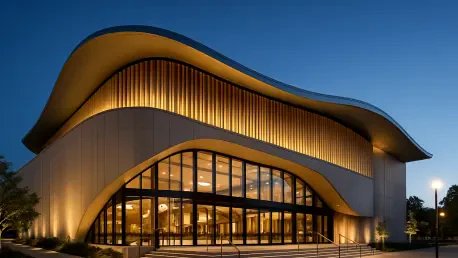In the heart of Canberra, Australia, a transformative vision is unfolding that could reshape the city’s cultural landscape with the unveiling of a proposed “world-class” Lyric Theatre. Nestled within the Civic and Cultural District at City Hill, this ambitious project, spearheaded by Cox Architecture alongside collaborators like Yerrabingin and Charcoal Blue theatre consultants, marks the first phase of a sweeping redevelopment of the Canberra Theatre Centre. Beyond just a new venue, the initiative promises to elevate the capital’s standing as a hub for artistic expression, blending innovative design with deep-rooted cultural respect. As plans come into focus, the theatre’s potential to host major performances and foster inclusivity sparks curiosity about whether it can truly set a new benchmark for cultural excellence in the nation.
A Vision for Architectural and Cultural Innovation
Designing a Landmark for the Capital
The Lyric Theatre’s design stands as a testament to architectural ingenuity, featuring a 2,000-seat auditorium thoughtfully arranged with 1,000 seats in the stalls, 500 in the circle, and 500 in the balcony. This tiered layout, crafted to optimize acoustics, ensures an intimate connection between performers and audiences, even in a venue of such scale. Beyond sound quality, the structure minimizes its visual bulk along key public frontages, seamlessly integrating into Canberra’s urban fabric. The exterior, with its layered design to filter light, enhances aesthetic appeal while framing iconic views of landmarks like Black Mountain and Vernon Circle. This careful balance of form and function reflects a broader ambition to create a space that not only serves as a performance venue but also as a civic icon, embodying the city’s identity and aspirations for a vibrant cultural future.
Blending Heritage with Modern Aspirations
A distinctive element of the Lyric Theatre project lies in its commitment to cultural sensitivity, ensuring that the venue resonates with diverse communities. Collaborations with First Nations and LGBTQIA+ groups have shaped a design that prioritizes storytelling and respect for the land, often referred to as “Country.” Joe Agius, Director at Cox Architecture, has highlighted the importance of grounding the theatre’s identity in continuity and respect, while Christian Hampson from Yerrabingin emphasized the shared connection between audiences and performers through acknowledgment of heritage. This approach positions the theatre as more than a building; it becomes a cultural landmark of national significance. By weaving contemporary Australian identity into its framework, the project aims to reflect Canberra’s evolving character while honoring the rich tapestry of histories that define the region.
Community Engagement and Future Horizons
Creating a Welcoming Public Space
At the core of the Lyric Theatre’s vision is the creation of an accessible and inviting public domain, with its main entry oriented toward a future Theatre Plaza designed for intuitive movement. This focus on accessibility extends beyond physical space, aiming to foster a sense of belonging for all who visit or perform there. As the initial phase of a broader precinct redevelopment, the theatre seeks to harmonize with Canberra’s urban environment, contributing to a cohesive cultural identity. Meanwhile, the ACT government’s plans for the adjacent City Hill Park, informed by community input and detailed site analysis, promise further enhancements to the area. The integration of these elements underscores a comprehensive approach to revitalizing the district, ensuring that the theatre serves as a catalyst for broader civic renewal and a space where shared experiences can flourish.
Public Input and Lasting Impact
The design of the Lyric Theatre has been shaped by a commitment to inclusivity, as evidenced by its public exhibition phase with the National Capital Authority, which allowed community feedback to influence the approval process. This step highlights the project’s dedication to reflecting local voices in shaping cultural infrastructure. Looking back, the initiative demonstrated how architectural innovation could be paired with deep respect for heritage, creating a venue that prioritized both artistic excellence and accessibility. The ongoing dialogue with stakeholders and the forthcoming masterplan for surrounding areas like City Hill Park lay a foundation for future considerations. Ultimately, the focus shifts to sustaining this momentum, ensuring that such projects continue to inspire and elevate community identity through thoughtful design and meaningful engagement across Australia’s cultural landscape.









